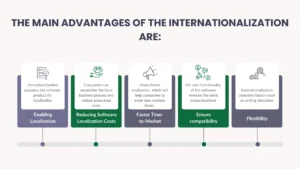SaaS Internationalization
SaaS internationalization services are some of the most needed services worldwide. Internationalization helps B2B business launch their software product on a global scale, reaching a global audience that was hard to reach using one-language software. Internationalization for SaaS businesses put them on a global stage allowing them to be seen by investors, users and developers.
With expert help such as Saudisoft, you will be able to go global smoothly. We will be showing you how Internationalization for SaaS is done but first let’s get to know its most important aspects that every decision maker should know.
Is Your SaaS Business Ready for Internationalization? Factors to consider and Questions to Answer
The growth of any SaaS company always meets the need of creation expansion opportunities and building some scalable processes and strategies to support them through their growth.
SaaS expansion might go vertically and horizontally, but some would go on a different way and look for opportunities in different countries that might have the need for their products. This allows them to boost their revenue growth and remains the most compelling compared to other strategies.
Many global businesses have followed this path and generated billions of dollars in revenue. Netflix for example, has generated millions by its media localization plan and the internationalization of its SaaS.

Netflix growth
A study from Statista highlights the growth Netflix has seen by expanding to global regions and the revenue collected in each of them.
Mckinsey & Company has a great article that mentions the importance of internationalization for SaaS and how going global can ensure a place between the giant companies.
According to Mckinsey in their research, they have studied the life spans of approximately 3,000 software and online services companies worldwide from 1980 to 2012. They have analyzed the life cycles of about 3,000 software and online-services companies from around the globe between 1980 and 2012.
This study identifies four important principles for continuous improvement that are beneficial to any company.
1. Growth occurs in stages, proceeding from a start-up to a billion-dollar giant, which often manifests as a relapse, one job, a second job.
2. The important drivers of growth in Act I are: markets, monetary policy, rapid adoption, stealth, and incentives.
3. The drivers of growth in the second phase are different, dominant strategies include expanding into new geographies or channels, extending success into new product markets, or changing offering platforms
4. Successful companies are adept at transitioning from one business to another, avoiding pitfalls such as changing at the wrong time or choosing the wrong strategy.
When it comes to the answer of is it the right time of internationalization of your SaaS?
Establishing a global audience seems highly achievable; However, this upward trend doesn’t mean your product or brand is fully ready for international expansion.
The three-question Global Readiness Assessment will help you understand whether it’s time for your SaaS to go global. Ask yourself these three questions:
1. Is your business solving a global problem?
2. Does your SaaS have a product-led and repeatable business across all markets?
3. Does your business need professional services or feet on the ground to complete the sales process?
These three questions can form a solid foundation for assessing your company’s readiness to expand globally. They can help you determine whether your business is ready for international expansion or whether it would be more beneficial to first strengthen its presence in the domestic market.
SaaS Localization VS SaaS Internationalization: Adapting to Diverse User Bases
The main differences between SaaS Localization and SaaS Internationalization are:
SaaS Localization involves modifying a Software-as-a-Service (SaaS) product to meet the specific language, culture, and application needs of the target market. It defines the user interface, content and documentation in the local language, ensuring that the software works properly in any target environment.
SaaS Internationalization, on the other hand, is the process of developing and manufacturing software so that it can be easily modified and adapted to different languages, regions and cultures requires a solid foundation available to the community by applying international collaboration best practices from the beginning with regards to software development.
SaaS Internationalization and software Localization, Are They the Same Thing?
SaaS internationalization and SaaS localization are as important as each other in software localization . Developing a software for a global audience happens on two phases which are internationalization and localization:
🔰 SaaS internationalization involves designing and developing software or mobile applications to be adapted and localized to different cultures, regions, and languages. It is the ability to configure code, materials and design in such a way that your product can be easily adapted for different cultures in the future, without the need for major reinvention.
🔰 Internationalization helps SaaS businesses build their software or mobile application products with future markets and languages in mind. Both localization and internationalization are considered two steps of the globalization process of a software.
🔰 Internationalization (often abbreviated as i18n) underlies the global variability of the software product. Specifically, internationalization involves designing software applications so they can be optimized for different languages and regions with minimal changes. Building platforms that meet business regulation standards or effortlessly integrating them into budgets to ensure that the core of your software remains robust and consistent. SaaS internationalization provides a solid foundation that can be adapted to specific regional needs without compromising the overall design and operation of the project.
🔰 Once the foundation of internationalization is established, SaaS localization (l10n) takes over the center stage. This strategy requires that the software be designed to meet the specific linguistic, cultural and local needs of the target audience. SaaS localization goes beyond just translation and ensures that the software matches the target market in a deeper way. It considers regional nuances, user preferences, and even regulatory standards to create a product that feels native and relevant to local users.
The Importance of SaaS Internationalization, Why It’s Considered the Magic Bill for Global Expansion?
Nimdzi published a report showing the importance of internationalization for businesses that are looking for global expansion. The deeper you go with your internationalization, the more your customers feel that they belong to your product.
These are some of the main benefits of SaaS internationalization software products gain when applying an internationalization strategy:
• Localized software design builds trust by demonstrating a company’s genuine understanding of its target market. When a platform takes into account the small cultural differences, customers are likely to have confidence that the provider truly understands their specific needs and preferences.
• To successfully reach new targets, software localization is essential to meet the local requirements, the language requirements and adapting the product to the unique cultural, regulatory, and business norms of the target market. This leads to greatly improve the chances of successful market expansion.
• When a software meets the local preferences, customers are less likely to switch platforms, as they believe the solution is tailored to their specific requirements. Which affects the user retention rate by increasing.
• Different regions often have different legal requirements. Local coordination of enforcement of these standards can prevent costly care and maintain compliance.
Yet, these are the final benefits of SaaS localization and SaaS internationalization implementation on a software product. But how can SaaS internationalization benefit you through your globalization process?
SaaS internationalization process lays the foundation for effective software localization. Before getting into localization, it is important to internationalize the software to make it easily adaptable to different languages, regions and cultures.
The main advantages of the internationalization are:
 Enabling Localization:
Enabling Localization:





